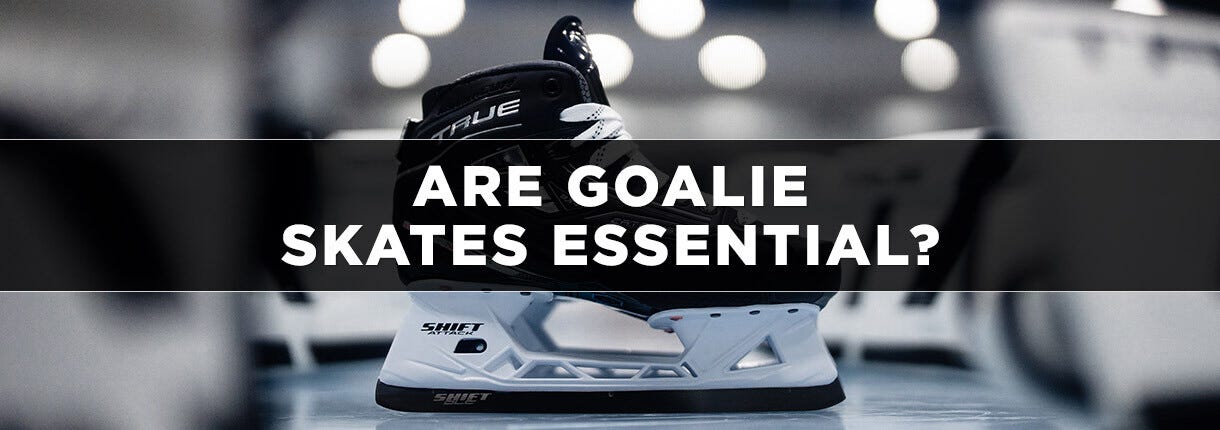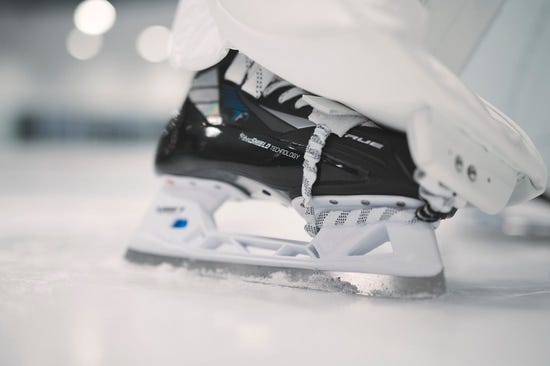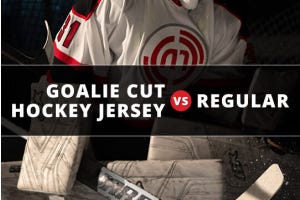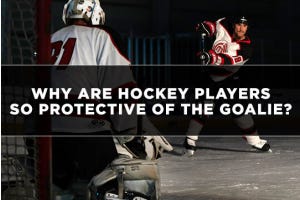Are Goalie Skates Essential?

When children begin learning to play the position of goalie in ice hockey, it is crucial for them to use goalie specific skates rather than player skates. There are several reasons for this, which encompass the differences in design, functionality, and the specific demands of the goalie position. Using player skates can hinder their development, safety, and performance. Here are the primary reasons why kids should not use player skates when learning to play goalie:
In this article, we will cover:
Design and Structure
When comparing the design of goalie skates and player skates, their differences are immediately apparent. Goalie skates are built for stability and lateral movement, featuring a lower-cut boot that enhances ankle mobility. This design allows goalies to transition quickly between standing and butterfly positions.
On the other hand, player skates are optimized for speed and agility. The higher cut boot provides excellent ankle support for skating strides, quick turns, and explosive acceleration. Blade designs also reflect these differences: goalie skates have shorter, wider blades to maintain balance in the crease, while player skates feature longer, narrower blades for increased maneuverability and speed.
Performance Requirements
Goalie skates and player skates serve distinct purposes in hockey, with designs tailored to their unique roles on the ice. Goalie skates prioritize stability and ease of movement for goaltenders, while player skates are optimized for speed, agility, and dynamic skating. Both are essential tools that cater to the specific demands of their respective positions.
| Feature | Goalie Skates | Player Skates |
|---|---|---|
| Lateral Movements | Excellent for post-to-post shuffling | Less effective due to restricted ankle mobility |
| Forward/Backward Skating | Limited, as goalies rarely skate at high speeds | Optimized for rapid acceleration and strides |
| Butterfly Drops | Designed for easy transitions to butterfly stance | Not suitable for frequent up-and-down motions |
| Turning Agility | Prioritizes stability over quick turns | Perfect for sharp turns and pivots |
Protection and Safety
Enhanced Protection for Goalies
Goalie skates are designed with extra padding and reinforced materials around the toe cap and sides of the skate to protect against high-speed puck impacts and stick slashes. This added protection ensures goalies can confidently face shots without fear of injury.
Lightweight Design for Players
While player skates lack the additional layers of protection found in goalie skates, they are lighter and streamlined to minimize fatigue. The reduced weight allows players to focus on speed and agility during intense gameplay.
Position-Specific Comfort
Goalie skates also prioritize comfort for goalies who spend much of the game crouched in a low stance. They feature a slightly wider fit and more customizable options, such as heat moldable materials, to accommodate prolonged use. Player skates, while snugger, emphasize a fit that supports quick, dynamic movements without compromising on responsiveness.
Weight and Comfort
Goalie Skates
Goalie skates are slightly heavier than player skates due to the additional protective features they incorporate. This extra weight is the result of reinforced toe caps, thicker sidewalls, and materials specifically designed to shield the goalie’s feet from high-speed pucks and the constant impacts of the crease. However, modern goalie skates utilize advanced lightweight materials, such as carbon fiber, to reduce weight while maintaining top-tier protection.
Comfort is another key focus in goalie skate design. Additional padding and customizable fit options ensure goalies can remain agile and comfortable during long periods in the crease. The skates are built with a lower cut around the ankle and a flexible structure to accommodate the crouching position and lateral movements that are integral to a goaltender’s game. This flexibility makes transitions between butterfly drops, lateral shuffles, and upright stances much smoother.
Player Skates
On the other hand, player skates prioritize speed and agility, making them significantly lighter. Their lightweight design reduces fatigue over the course of a game and allows players to generate faster strides. Additionally, the snug, form-fitting design enhances energy transfer, enabling explosive acceleration and sharp directional changes.
Customization and Fit


Goalie skates and player skates differ in their fit and customization to meet the specific needs of each position. Goalie skates emphasize movement and protection, while player skates focus on agility and responsiveness. Both offer various customization options to enhance performance and comfort.
| Feature | Goalie Skates | Player Skates |
|---|---|---|
| Fit Requirements | Specific fit for movement and protection | Tight, responsive fit for agility and control |
| Customization Options | Custom footbeds, padding, blade profiles | Insoles, lacing patterns, blade holders |
Price and Availability
Cost Differences
While goalie skates don’t necessarily cost more than player skates, the key difference lies in the range of options available. Player skates come in a wide variety of models across all price points, from entry-level to elite. Goalie skates, on the other hand, typically have fewer options, with pricing focused on beginner, intermediate, and advanced levels.
Market Availability
Player skates dominate the market with an extensive selection designed to suit every skill level and budget. Goalie skates, although more specialized, offer enough variety to meet the needs of goalies at different stages of play.
Usage and Maintenance


- Care and Maintenance:
- Goalie Skates: Regularly check and replace protective features, sharpen blades less frequently but with a specific goalie profile.
- Player Skates: Frequent blade sharpening, regular checks for wear and tear on the boot and laces.
- Durability:
- Goalie Skates: Designed to withstand the rigors of constant impact and abrasion in the crease.
- Player Skates: Durable for the demands of aggressive skating, turning, and stopping.
Technology and Innovation
Goalie skates and player skates are designed with different technological innovations and materials to suit their respective roles on the ice. Goalie skates focus on lightweight yet durable materials for added protection, while player skates utilize advanced boot construction and blade technology for optimized performance and speed.
| Aspect | Goalie Skates | Player Skates |
|---|---|---|
| Technological Advances | Lightweight materials, enhanced protection | Boot construction, blade technology |
| Material Differences | High-strength composites for protection | Lightweight composites for performance |
Functional Requirements
Movement and Agility
Goalie skates are essential for lateral movements like shuffling and quick transitions from standing to a butterfly position. Their wider blades and lower cut boots are specifically designed to support these actions. Player skates, optimized for forward and backward skating, cannot meet the lateral and vertical demands of a goalie, making it challenging for kids to learn key techniques.
Stance and Positioning
A goalie’s unique stance requires the balance and flexibility provided by goalie skates. Player skates can lead to improper techniques that become difficult to correct later in a goalie’s development.
Developmental Impact
Goalie skates and player skates impact a player's development and confidence on the ice in different ways. Goalie skates are designed to facilitate specific goalie skills like sliding and butterfly saves, while player skates focus more on agility and speed but may not support the specialized needs of goalies, potentially hindering their growth and enjoyment.
| Aspect | Goalie Skates | Player Skates |
|---|---|---|
| Skill Development | Facilitates proper sliding, butterfly saves | Hinders goalie-specific skill development |
| Confidence and Comfort | Boosts comfort, security, and confidence | Can cause frustration and hinder enjoyment |
Frequently asked Questions
Why can't children use player skates when learning to play goalie?
Player skates are designed for different movements and lack the specific features necessary for goalies, such as enhanced lateral mobility, protection, and proper support for goaltending techniques.
What are the main differences between goalie skates and player skates?
Goalie skates have a lower cut boot for ankle mobility, shorter and wider blades for stability, extra padding for protection, and are designed for lateral movements. Player skates have a higher cut for ankle support, longer and narrower blades for speed, and are optimized for forward and backward skating.
How do goalie skates enhance performance for young goalies?
Goalie skates support quick lateral movements, butterfly stance transitions, and provide the necessary balance and protection, which are crucial for developing proper goaltending skills.
Are goalie skates more expensive than player skates?
Generally, yes. Goalie skates tend to be more expensive due to their specialized design and additional protective features.
Can using player skates hinder a child's development as a goalie?
Yes, using player skates can hinder a young goalie's ability to learn and perform essential techniques, potentially leading to improper form and increased injury risk.









Login and Registration Form
or
Create an account